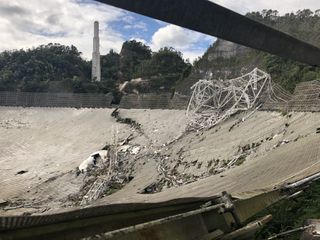Arecibo Observatory: A year after telescope's collapse, an icon gets continuing cleanup and a new documentary

A year after the collapse of an iconic radio telescope tucked away in a natural sinkhole, scientists and Puerto Ricans are still reeling from the loss of a decades-old observatory.
Arecibo Observatory's radio telescope was instantly recognizable, thanks to its 1,000-foot-wide (305 meters) dish, trio of soaring towers and delicate web of cables and platform that held science instruments above the dish.
But in late 2020, first one cable failed, then a second one. By mid-November, the U.S. National Science Foundation (NSF), which owns the site, decided that the telescope was too unstable to be repaired — but before the agency could demolish it, gravity did the job. On Dec. 1, 2020, the platform fell, smashing through the delicate dish.
Related: Scientists want to build a new, very different Arecibo Telescope to replace fallen icon
The collapse left Arecibo's dedicated science community reeling — and wondering what would come next for the site. A year later, that's still unknown. The NSF has prioritized cleaning up the site over making any big decisions about the facility's future, even as scientists begin dreaming up ambitious ideas to carry on the iconic telescope's legacy.
A special telescope
The radio telescope began observations in 1963 and was unique in that it was a valuable tool for three different scientific fields: studying Earth's atmosphere, detecting radio light from the universe around us (including possible signals from intelligent aliens), and using an active radar system to study the solar system, particularly near-Earth asteroids. Over the decades, the telescope also became an icon of Puerto Rico, as well as a film star thanks to appearances in "GoldenEye" and "Contact."
Now, the telescope stars in a new film: "The Biggest Dream," a documentary about Arecibo's origins, legacy and loss. The film premieres in special showings in Puerto Rico this week and is scheduled to begin showings beyond the island next year.
Get the Space.com Newsletter
Breaking space news, the latest updates on rocket launches, skywatching events and more!
"The creation of the film reflects the Puerto Rican spirit and demonstrates the magnitude of the contributions this facility and its people have made to the scientific community," Arecibo Observatory director Francisco Cordova said in a statement released by the University of Central Florida, which manages Arecibo Observatory.
A trailer available on YouTube offers a glimpse of the documentary.
"I have no words to explain what an honor it was to tell the story of the Arecibo Observatory," producer and director Andrew Hernandez said in the statement. "I dedicate this film to the great dreamers who decide to believe that they can bring positive changes to this world by inspiring others."

Continuing cleanup
Meanwhile, in a report released Nov. 17, the NSF offers the first update about the site's status since the summer.
"The emergency cleanup team has completed the majority of the emergency cleanup and repairs," NSF officials wrote in the report. "Next steps include completing repairs to areas with damaged concrete, removal of work vehicles and equipment from the site and storage of salvaged items."
Over the past months, on-site crews have worked on tasks including planting greenery to hold soil in place, testing groundwater, identifying and removing soil contaminated with hydraulic oil and removing two large pieces of concrete that broke off one of the three supporting towers.
Related: These photos of the Arecibo Observatory telescope collapse are just heartbreaking
In addition, crews have removed some 38,000 metal panels covering more than one-third of the dish's surface, which had incurred damage during the collapse and clean-up. Crews have also installed a temporary, hurricane-proof roof on the observatory's learning center and patched minor damage to the visitor center's roof and observation deck.
(An estimate from March suggests the cleanup process could cost the NSF $50 million.)
An investigation into what caused the collapse is also continuing, according to an NSF spokesperson, although, "to date, no obvious single point failure has been identified."
Thanks to the decades-long legacy of Arecibo, the NSF must also evaluate how to manage the site with an eye toward history. Although no details are offered, the report notes that the NSF and UCF met with the Puerto Rico State Historic Preservation Office and the Advisory Council on Historic Preservation in June and are scheduled to do so again this autumn.
The report also notes that in 2021, the NSF established a separate Salvage Survey Committee, which included experts familiar with the site and which evaluated objects of "potential scientific, cultural, or historic value to be preserved for potential display at the site or in other museums," according to the report. The committee's work resulted in a report submitted to the NSF in September that is not yet available online.
What's next for science at the site is relegated to a corner of the last page of the Nov. 17 update, where the NSF highlights the workshop series it held this summer with members of Arecibo's science community to begin talking through opportunities that Arecibo Observatory may offer into the future.
Email Meghan Bartels at mbartels@space.com or follow her on Twitter @meghanbartels. Follow us on Twitter @Spacedotcom and on Facebook.
Join our Space Forums to keep talking space on the latest missions, night sky and more! And if you have a news tip, correction or comment, let us know at: community@space.com.

Meghan is a senior writer at Space.com and has more than five years' experience as a science journalist based in New York City. She joined Space.com in July 2018, with previous writing published in outlets including Newsweek and Audubon. Meghan earned an MA in science journalism from New York University and a BA in classics from Georgetown University, and in her free time she enjoys reading and visiting museums. Follow her on Twitter at @meghanbartels.
